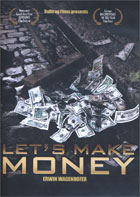
Let’s Make Money 2008
Distributed by Bullfrog Films, PO Box 149, Oley, PA 19547; 800-543-FROG (3764)
Produced by Allegrofilm
Directed by Erwin Wagenhofer
DVD, color, 107 min.
College - Adult
Business, Economics, Political Science
Date Entered: 09/20/2010
Reviewed by Michael J. Coffta, Business Librarian, Bloomsburg University of PennsylvaniaThis innovative documentary focuses on investment specialists and industrialists throughout the world and their thoughts on globalization, investment criteria, and movement of monies throughout the world. They grant perspectives on the pressures of globalization, and specifically how investments affect cultures and institutions worldwide. Simply put, the film sets out to answer the questions of how investments increase in value, and how, exactly, interest payments are generated. The film presents, quite literally, a factory floor peek into thought processes of executives for growth, emerging markets, and efficiency. The film shifts to an agricultural perspective, showing the plight of cotton pickers in Africa. Even though they are producing high quality crops for a low labor cost, the margins are woefully low due to low market values. It is the stress of demand and increase in market capitalization that contorts such markets, causing disadvantaged conditions for workers and underleveraged stakeholders.
Let’s Make Money changes its bend once again and examines the “theory into practice” of the liberal economy, neoliberalism, [de facto] protectionism, globalization, deregulation and privatization. Interests of private investors, and ethical responsibilities involved. It then studies the plight of those living in destitution (worse than poverty) in India and Africa. The film then delivers some immense substance, as it interviews a former “economic hit man,” who organized loans to companies (not governments) in countries with great resources and little working capital. In return for these loans, a hit man will receive cheaper prices on behalf of a sponsor nation, UN votes, and other weighty favors. The hit man gives an astoundingly candid account of his activities, giving particulars from events in Panama and Iraq. The film goes on to discuss economic “locusts,” which buy the capital of companies with low equity capital, and restructure it as a security for sale. The film concludes with the disturbing exposition of tax havens that provide protection and secrecy to aid private investors in avoiding taxes and penalties.
This is an excellent film, but it takes a while to gain traction. There is no dialog for the first seven minutes of the documentary. While information and tone may be created visually, it is not until the second quarter of the film that it truly gains impetus. There are scenes with very odd camera angles, such as the interviewing of a man as he drives, while the audience views the back of his head. Although the film would have benefited from some leaner production, this does not detract from the outstanding content, especially in the staggering material on economic “hit men” and “locusts.” That content alone makes this film a resounding enterprise.